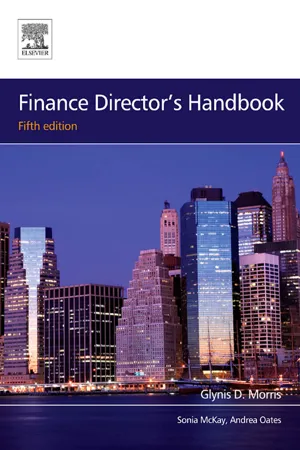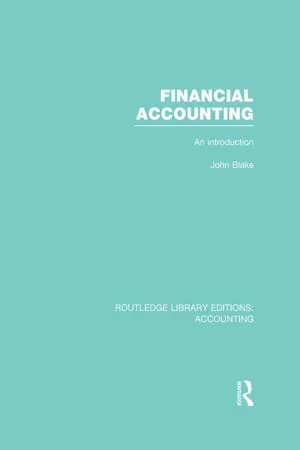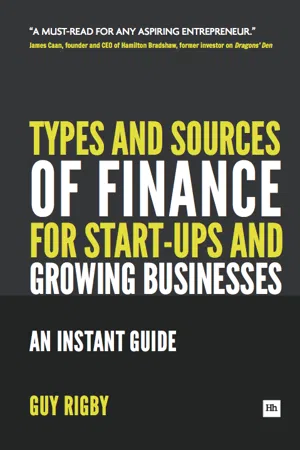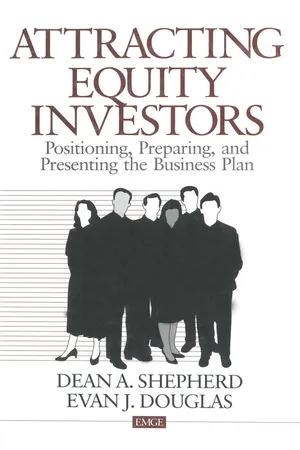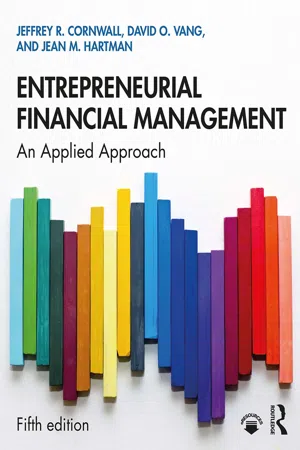Business
External Sources of Finance
External sources of finance refer to funds obtained from outside the business, such as through loans, issuing bonds, or seeking investment from external parties. These sources provide businesses with additional capital to fund operations, expansion, or investment in new projects. By utilizing external sources of finance, businesses can access resources beyond their internal funds to support growth and development.
Written by Perlego with AI-assistance
Related key terms
1 of 5
10 Key excerpts on "External Sources of Finance"
- eBook - ePub
- Glynis D Morris, Sonia McKay, Andrea Oates(Authors)
- 2009(Publication Date)
- CIMA Publishing(Publisher)
Chapter 24. Sources of Finance24.1. The Search for Finance
At a Glance
■ The business development giving rise to the need for additional funding will often indicate the most appropriate source of finance. ■ Grant funding should always be considered, but this is unlikely to meet the full cost of any project. ■ It is generally unwise to attempt to finance major purchases or business development from a bank overdraft. ■ Any application for finance will need to demonstrate the credit-worthiness and viability of the business to the potential financier. ■ Issues such as overall cost, flexibility and level of security required will all need to be taken into account in deciding on the best option.24.2. P lanning the S earch
Sound business structures and operations need to be financed properly, and there will come a time in the life of every business when additional funds are needed, either to purchase fixed assets, to fund a particular initiative or development within the business or to enable the strategic plan for the business to be put into place. The business development giving rise to the need for funding will usually indicate the most appropriate source of finance, and the term of the finance should generally be matched as far as possible with the life of the asset or project. Grant funding should always be considered, although this is unlikely to meet the full cost of any project; thus, the business will usually need to raise some funds from other sources as well. Some form of loan finance, including options such as leasing, will usually be the most appropriate method of funding asset purchases, whereas funding from other investors may be needed to finance the longer-term development of the business. It is generally unwise to attempt to finance major purchases or business development from a bank overdraft – the rate of interest will usually be unacceptably high and overdrafts are repayable on demand, allowing the bank to withdraw the facility at any time if it was unsatisfied with the progress or management of the business. - eBook - ePub
Financial Accounting (RLE Accounting)
An Introduction
- John Blake(Author)
- 2013(Publication Date)
- Routledge(Publisher)
8SOURCES OF FINANCE
This chapter has two broad objectives:Objectives1To give an introduction to the various sources of finance shown in a business balance sheet, explaining their significance and how they are accounted for.Specifically we consider2To introduce the major factors taken into account in deciding how to raise finance for the establishment, running, and expansion, of a business.1The ways in which new shares can be issued.2Retained profits as a source of finance.3Forms of long-term borrowing.4Types of short-term borrowing.5The nature of the tax liabilities shown in the balance sheet.6Sources of finance which do not appear in the balance sheet.7The effect of the financial structure on fluctuations in profit (gearing).8The relationship between the trading structure and the financial structure.9The factors taken into account in choosing between sources of finance.Raising funds from share issuesOne of the sources from which a new company will derive funds will be from the issue of shares in the business. If additional finance is required during a company's life an issue of new shares is one way of raising finance that might be considered. In this respect a private company, which is not permitted to issue any form of security to the public, is at a severe disadvantage compared to a public company. A public company will normally only be able to benefit from the legal permission to issue securities to the public if it is listed - eBook - ePub
SME Finance and the Economic Crisis
The Case of Greece
- Alina Hyz(Author)
- 2019(Publication Date)
- Routledge(Publisher)
It is not possible to start and continue operation of a business without adequate financial resources. Their use is related to the creation of a specific financial structure that can affect both the current financial condition of the company and its value. The company’s financing sources are visible on the liabilities side of the balance sheet of the business unit. They may be divided into different categories depending on the criteria we use. According to the duration of use, we can distinguish long-term financing sources, which are involved and necessary to return throughout one year from their acquisition, and short-term financing sources, which are acquired by the company for less than one year of use. When they are generated from the current activity of the company, they belong to the internal sources of financing. Internal financing sources are also referred to as self-financing. When they are obtained from the financial environment of the enterprise, they create an external source of financing. Firms can choose from a range of external financing instruments, in particular, equity, bank loans, debt securities, inter-company loans, and trade credit. This opportunity of choice provides them with flexibility in their decision of financing of working capital and investment (Storey, 1994; Berger and Udell, 1998). According to the use of capital, they are divided into fixed capital, which includes equity and long-term liabilities, and working capital financing current assets of the enterprise. These are primarily short-term liabilities.Proper determination of the value of assets and share of equity and debt plays a vital role in the rational use of the company’s capital resources. Mutual relations between the structure of assets and sources of financing result mainly from the specific nature of the company’s operations and the nature of the industry in which it operates.Depending on mutual balance relations, two groups of rules are distinguished:- The rules of the horizontal structure of the capital and assets.
- The rules of the vertical structure of capital.
- The golden funding rule (banking or classic), according to which debt should be fully covered by equity.
- The golden balance sheet rule, which requires that fixed assets which are characterised by a low degree of liquidity should be fully financed with equity. The broader approach assumes financing fixed assets and part of current assets with the company’s fixed capital, that is, equity and long-term liabilities.
- eBook - PDF
- Andrew Zacharakis, William D. Bygrave(Authors)
- 2019(Publication Date)
- Wiley(Publisher)
Managers or owners of large, mature firms, in contrast, have access to profits from operations as well as funds from external sources. We distinguish internal from external funds because internal funding sources do not require external analysts or investors to independently appraise the worthiness of the capital investments before releasing funds. External investors and lenders also don’t share the entrepreneur’s vision, so they may view the potential risk/return trade‐off in a different vein and demand a relatively certain return on their investment after the firm has an established financial track record. Figure 11.1 shows a listing of funding sources and approximately when a firm would use each. In the embryonic stages of a firm’s existence, as we’ve discussed, much of the funding comes from the entrepreneur’s own pocket, including personal savings accounts, credit cards, home equity lines, and other assets such as personal computers, in‐home offices, furniture, and automobiles. Soon after entrepreneurs begin tapping their personal fund sources, they may also solicit funds from relatives, friends, and banks. Entrepreneurs would generally prefer to use other people’s money (OPM) rather than their own because if their personal investment turns sour, they still have a nest egg to feed themselves and their families. The need to protect a nest egg may be particularly acute if the entrepreneur leaves a viable job to pursue an entrepreneurial dream on a full‐time basis. - eBook - ePub
Types and Sources of Finance for Start-up and Growing Businesses
An Instant Guide
- Guy Rigby(Author)
- 2011(Publication Date)
- Harriman House(Publisher)
Types and Sources of Finance for Start-up and Growing Businesses
“Money often costs too much.” — Ralph Waldo EmersonShow me the money
There is more to life than equity. Businesses will normally have access to a variety of different types and sources of finance. The trick is in learning to combine these to create financial stability and maximise shareholder returns.It may seem counter-intuitive but, in a successful business, external equity is likely to be the most expensive source of finance. It will ultimately create value for the investor far in excess of that available from deposits or similar investments and will deprive the founder of this value. From the founder’s perspective, this may represent a significant and unwelcome opportunity cost.In addition, using equity as a sole means of funding may reduce risk but it will also reduce returns. Take the example of an investor who buys for £100 and sells for £150 – a good return of 50%. Now consider the same situation, but imagine that £75 of the investor’s original investment is borrowed, leaving only £25 as the equity investment. Ignoring the interest cost on the borrowing which, admittedly, is an over simplistic approach, the equity of £25 becomes equity of £75 (i.e. £150 - £75). In this case the investor’s equity return rises to 200%, a far more satisfying result.This is known as the gearing or leverage effect, where non-equity funding can be used to boost equity returns.In practice, lenders will not make unlimited loans, so the ability to gear the equity with borrowings will be dictated by market conditions and the assets or cash flows available to secure or service them. In addition, businesses that are highly geared (i.e. those with large borrowings in relation to their equity) are more likely to face difficulties in the event of a slowdown in demand or an unexpected loss.As always, it’s a question of balance. The equity, which is the fixed capital of the business, needs to be sufficient to support the business after all other factors have been taken into account, with sufficient headroom to weather unexpected storms, should these occur. - eBook - PDF
Attracting Equity Investors
Positioning, Preparing, and Presenting the Business Plan
- Dean A. Shepherd, Evan J. Douglas(Authors)
- 1998(Publication Date)
- SAGE Publications, Inc(Publisher)
X I Sources of Early-Stage Financing T he number of new enterprises launched in the United States has grown rapidly from about 1 million in 1981 to 18 million in 1988, and it is estimated to reach 30 million by the year 2000. l These new, 2 small, and expanding firms generate virtually all new jobs. 3 They also generate 50% of all innovations and 95% of all radical innovations. 4 Access to early-stage capital is one of the key contributing factors to new venture survival and growth and, thus, to increased employment and ongoing technological innovation. Raising capital is important to all firms but in particular to new ventures whose growth gives them an amazing appetite for cash. For example, Briazz, a Seattle-based salad and sandwich café chain, required equity capital to fund national expansion. They raised $19 million from a group of investors. The iCat.Corp required and obtained a similar amount of money to maintain their lead in creating software for inter-active internet catalogues. 5 Growing companies like Briazz and iCat.Corp may require a number of infusions of cash to fund their continued growth. On the other hand, Chris, a retired supermarket manager who intends to set up Sail Away, a yacht-charter business on Grand Cayman island in the Caribbean, expects to require only initial funding, inasmuch as operating revenues are expected to exceed operating expenses once he begins operations. Thus, some companies require only an initial infusion of cash and can fund future growth from profits (retained earnings), whereas other 1 2 ATTRACTING EQUITY INVESTORS potential business owners are not seeking growth and seek only the capital necessary to start or purchase the business. DEBT VERSUS EQUITY The two main sources of capital are debt and equity. Debt usually is more difficult to obtain, because new ventures lack a track record of sales and usually also lack collateral to pledge against the loan. - eBook - PDF
- Simon C. Parker(Author)
- 2018(Publication Date)
- Cambridge University Press(Publisher)
10 Venture Capital and Business Angel Finance Chapter 9 discussed debt financing of entrepreneurial ventures. While debt is the domi- nant form of external finance for most start-ups, many entrepreneurs also tap alternative sources of external funding. Prominent among these is equity finance, in which investors receive an ownership share (‘equity’) in return for their investment. ‘Formal’ equity finance, provided by institutional investors dedicated to this purpose, is known as ven- ture capital; ‘informal’ equity finance, provided on a more ad hoc basis by private individuals, is known as business angel finance. This chapter focuses on both types of equity finance. An extensive literature now documents the role of equity – especially venture capital – in financing high-growth and high-tech entrepreneurial ventures. Venture capital has been used to finance such well- known companies as Apple, Google, Amazon, Federal Express and eBay, among many others. Venture capital tends to be ‘narrow but deep’, in the sense that few entrepreneurs use it but those who do so can access very large sums of money from it. In contrast to debt finance (DF) contracts, which stipulate in advance a given repay- ment due to a bank that is invariant to gross returns from a venture, an equity finance (EF) contract entitles a lender to a stake, or share, of a firm’s profits. The evidence shows that projects receiving EF tend to have particular characteristics that set them apart from those which do not, including: a lack of tangible assets; the prospect of years without positive cash flows; and high levels of market and strategic uncertainty (Winton and Yer- ramilli, 2008). Banks do not usually finance these kinds of investments, and moreover usually require collateral which many high-risk and high-tech projects do not possess (Gompers and Lerner, 1999; Freel, 2007). - eBook - PDF
State-owned Enterprises In A Mixed Economy
Micro Versus Macro Economic Objectives
- Mehdi Haririan(Author)
- 2019(Publication Date)
- Routledge(Publisher)
In this chapter, some of government's soft options that also affect macroeconomic variables will be studied. The consequences of these choices will be described at the end of this chapter, and the empirical study will be presented in Chapter 4. Different Sources of Finance The financial needs of SOEs arise from their social obligations as well as their engagement in risky, capital-intensive activities. These may in-clude financing deficits, replacing equipment, expanding existing capacity, or extending the SOE into new and diversified areas of production. The 38 availability of financing sources for SOEs is directly related to the stage of development and growth of their respective countries. In this context, public enterprise finance may be broadly defined as mechanisms for raising funds, distributing profits, and absorbing losses (Gillis, Jenkins, and Lessard 1982, 257). Financing may be divided into two main categories that, in tum, may be further divided into subcategories. The sources of finance may be domestic or foreign, the latter being more important in the case of develop-ing countries. Foreign financing may take the form of floating bond issues in overseas markets or direct borrowing from commercial banks. Yet, in other cases, international agencies or foreign governments may provide loans and other financial assistance. Domestic financing has more soft options. Bond issues may be floated in domestic markets, and loans may be sought either from commercial banks or government agencies. Equity capital may be sold domestically, but international sales of equity may create problems of control. The type of equity issued domestically may vary in order to minimize conflict between stockholders and governmental agencies because the latter may have NCOs. If the NCOs of an SOE are important, government grants may be needed to provide the necessary social capital. - eBook - PDF
Small Business
Creating Value Through Entrepreneurship
- Vishal K. Gupta(Author)
- 2021(Publication Date)
- Wiley(Publisher)
The word finance seems to have French origins and was later adopted by English speakers in about the eighteenth century. Over time, the term was used in many different fields, and has come to be defined in many ways, depending on who is using it. At a broad level, finance relates to obtaining money, investing money, and understand- ing the cost and use of money. It is used for individuals (as in personal finance), for com- panies (corporate finance), and also for governments and countries (public finance). Financing is a critical issue at all stages of a company life (see Figure 8.1). The seed stage of a company begins with an idea for introducing a new offering in the market. In most cases, there is no formal venture yet, but the founders will have identified a specific opportunity and be willing to devote time to it. Sometimes reaching the market and getting the first paying customer may be quite quick (as happened to both Microsoft and Apple when they first started). At other times, successfully reaching the market may take a very long time (as, for example, happens to biotechnology firms where the pro- cess of product validation and approval can take years). The seed stage, therefore, varies based on the activity of the business and its specific attributes. Depending on the type of business they are in, the founders will need funding to finance the venture until they start selling. What will they do with the funding? Salaries need to be paid, assets need to be acquired, and suppliers need to be compensated. At this stage, we are squarely in the realm of personal finance. Consider Ken Deckinger, who avoided asking others for money to grow his fledg- ling online dating service Jess Meet Ken. During the first year of the company, Ken put in more than $100,000 in personal savings into the business. His website accumulated roughly 10,000 users, women who pay monthly fees of $9–$23 to be introduced to poten- tial dates. - No longer available |Learn more
Entrepreneurial Financial Management
An Applied Approach
- Jeffrey R. Cornwall, David O. Vang, Jean M. Hartman(Authors)
- 2019(Publication Date)
- Routledge(Publisher)
The forecasted financial statements developed for Sally Warner’s business show cash flow projections that include both operating cash flow needs and assets that will need to be purchased. She has carefully evaluated these projections and determined there is some room for bootstrapping her venture during start-up. The total financing required is thus determined to be about $380,000, rather than the $500,000 initially estimated.Table 13.1Example of Assets and Potential Funding GeneratedThe entrepreneur’s personal assets (such as bank accounts, retirement accounts, and publicly traded stocks) are worth another $150,000, and another $120,000 can be borrowed by pledging these assets. Therefore, between debt financing of $214,000 using the various business assets, and investing personal equity of $120,000 raised from her personal assets, she will have $334,000 of the $380,000 to fund the venture, which leaves $46,000 in equity that needs to be raised to fund the assets of the business. She is reasonably confident that she can go to friends and family for this amount of funding. This example demonstrates the variety of funding sources that can go into the financing plan of a single deal.SUMMARYThis chapter has discussed external debt as a source of funding for entrepreneurial ventures. Sources of short-term debt include trade debt, bank debt, asset-based lenders, and factors. Sources of long-term debt include banks, real estate lenders, and leasing companies. The SBA can guarantee bank loans for some small business uses. Entrepreneurs must learn to develop a good working relationship with their bankers and create a strategy that can include an array of sources of debt funding. Finally, debt, although used by almost all businesses to some degree, requires prudent and careful planning. The next chapter will examine venture capital equity funding, which is available only for those few ventures that are considered high-growth, high-potential businesses.DISCUSSION QUESTIONS- Discuss the various types of short-term credit. What are the best uses for each type? What should an entrepreneur do to establish each form of short-term credit?
- How can entrepreneurs manage their own business’ credit risk?
- Discuss the various types of long-term credit. What are the best uses for each type? What should an entrepreneur do to establish each form of long-term credit?
Index pages curate the most relevant extracts from our library of academic textbooks. They’ve been created using an in-house natural language model (NLM), each adding context and meaning to key research topics.
